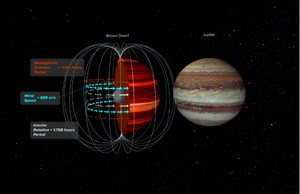New Insight into Brown Dwarf Atmospheres
 Zonal (latitudinal) winds dominate the bulk flow of planetary atmospheres. For gas giant planets such as Jupiter, the motion of clouds can be compared with radio emissions from the magnetosphere, which is connected to the planet’s interior, to determine the wind speed. In principle, this technique can be applied to brown dwarfs, the most common stellar type, and/or directly imaged exoplanets, if periods can be determined for the infrared and radio emissions. In this paper, the authors apply this method to measure the wind speeds on the 40MJ brown dwarf 2MASS J10475385+2124234. The difference between the radio period of 1.751 to 1.765 hours measured with the Jansky Very Large Array, and infrared period of 1.741 ± 0.007 hours measured with the Spitzer Space Telescope, implies a strong wind proceeding eastward of 650 ± 310 meters per second, 6X the winds on Jupiter. This could be due to atmospheric jet streams and/or low frictional drag at the bottom of the atmosphere.
Zonal (latitudinal) winds dominate the bulk flow of planetary atmospheres. For gas giant planets such as Jupiter, the motion of clouds can be compared with radio emissions from the magnetosphere, which is connected to the planet’s interior, to determine the wind speed. In principle, this technique can be applied to brown dwarfs, the most common stellar type, and/or directly imaged exoplanets, if periods can be determined for the infrared and radio emissions. In this paper, the authors apply this method to measure the wind speeds on the 40MJ brown dwarf 2MASS J10475385+2124234. The difference between the radio period of 1.751 to 1.765 hours measured with the Jansky Very Large Array, and infrared period of 1.741 ± 0.007 hours measured with the Spitzer Space Telescope, implies a strong wind proceeding eastward of 650 ± 310 meters per second, 6X the winds on Jupiter. This could be due to atmospheric jet streams and/or low frictional drag at the bottom of the atmosphere.
Figure caption: [Left] Brown dwarf and [Right] Jupiter. Artist's conception of brown dwarf illustrates magnetic field and atmosphere's top, which were observed at different wavelengths to determine wind speeds. Credit: Bill Saxton, NRAO/AUI/NSF.
Publication: Katelyn Allers (Bucknell University) et al., A Measurement of the Wind Speed on a Brown Dwarf, Science, 368, Issue 6487, 169 (10 April 2020).
NRAO Press Release: Astronomers Measure Wind Speed on a Brown Dwarf




Connect with NRAO